Related Research Articles

The .38 Special, also commonly known as .38 S&W Special, .38 Smith & Wesson Special, .38 Spl, .38 Spc,, or 9x29mmR is a rimmed, centerfire cartridge designed by Smith & Wesson.

Smith & Wesson Brands, Inc. (S&W) is an American firearm manufacturer headquartered in Springfield, Massachusetts, United States.

The Colt Single Action Army is a single-action revolver handgun. It was designed for the U.S. government service revolver trials of 1872 by Colt's Patent Firearms Manufacturing Company and was adopted as the standard-issued pistol of the U.S. Army from 1873 until 1892.
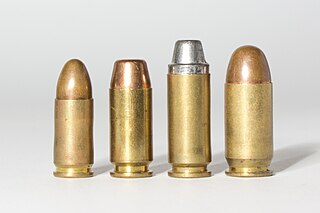
The 9×19mm Parabellum is a rimless, tapered firearms cartridge.

Ethan Allen was a major American arms maker from Massachusetts. He is unrelated to the revolutionary Ethan Allen. His first firearm, the "Pocket rifle" was developed in 1836, and his first patent was granted in 1837.

The .38 S&W, also commonly known as .38 S&W Short, 9×20mmR, .38 Colt NP , or .38/200, is a revolver cartridge developed by Smith & Wesson in 1877. Versions of the cartridge were the standard revolver cartridges of the British military from 1922 to 1963. Though similar in name, it is not interchangeable with the later .38 Special due to a different case shape and slightly larger bullet diameter.
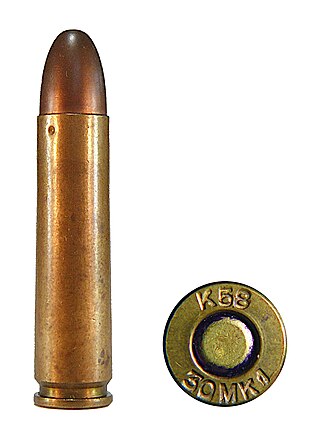
The .30 Carbine (7.62×33mm) is a rimless carbine/rifle cartridge used in the M1 carbine introduced in the 1940s. It is a light rifle round designed to be fired from the M1 carbine's 18-inch (458 mm) barrel.
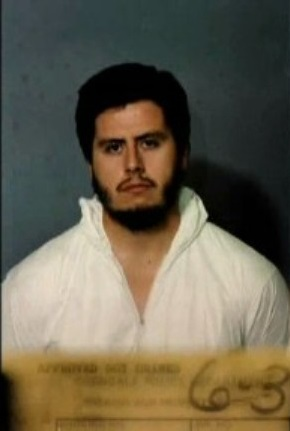
The North Hollywood shootout was a confrontation between two heavily armed and armored bank robbers, Larry Phillips Jr. and Emil Mătăsăreanu, and members of the Los Angeles Police Department (LAPD) in the North Hollywood district of Los Angeles, California, United States on February 28, 1997. Both robbers were killed, twelve police officers and eight civilians were injured, and numerous vehicles and other property were damaged or destroyed by the nearly 2,000 rounds of ammunition fired by the robbers and police.

A shootout, also called a firefight, gunfight, or gun battle, is a combat situation between armed parties using guns. The term can be used to describe any such fight, though it is typically used in a non-military context or to describe combat situations primarily using firearms.

The Smith & Wesson Model 10, previously known as the Smith & Wesson .38 Hand Ejector Model of 1899, the Smith & Wesson Military & Police or the Smith & Wesson Victory Model, is a K-frame revolver of worldwide popularity. In production since 1899, the Model 10 is a six-shot, .38 Special, double-action revolver with fixed sights. Over its long production run it has been available with barrel lengths of 2 in (51 mm), 3 in (76 mm), 4 in (100 mm), 5 in (130 mm), and 6 in (150 mm). Barrels of 2.5 inches (64 mm) are also known to have been made for special contracts. Some 6,000,000 of the type have been produced over the years, making it the most popular handgun of the 20th century.
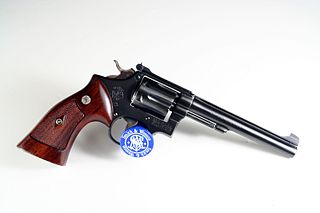
The Smith & Wesson Model 17 is a six-shot double-action revolver chambered for .22 LR. It is built on Smith & Wesson's medium-sized K-frame.
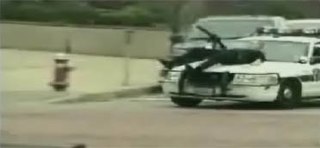
On February 24, 2005, a man shot his ex-wife and son outside the courthouse in Tyler, Texas, then engaged police and court officers in a shootout. David Hernandez Arroyo, Sr. opened fire in front of the courthouse with a Type 56S rifle, killing his ex-wife, and wounding his son. A downtown resident, Mark Alan Wilson, attempted to intervene but was fatally shot. Arroyo was fatally shot by police after a high-speed pursuit.

The Colt Detective Special is a six-shot, carbon steel framed, 2-inch (5.1 cm) or 3-inch (7.6 cm) barreled, double-action revolver, and the first example of a class of firearms known as "snubnose revolvers". Made by Colt's Manufacturing Company, this model revolver, as the name "Detective Special" suggests, was intended to be a concealed weapon used by plainclothes police detectives.

A handgun is a firearm designed to be usable with only one hand. It is distinguished from a long gun which needs to be held by both hands and braced against the shoulder. The two most common types of handguns are revolvers and semi-automatic pistols, although other types such as derringers and machine pistols also see infrequent usage.
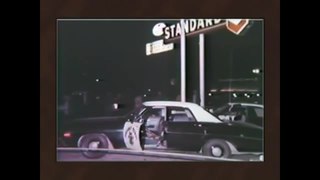
The Newhall incident, also called the Newhall massacre, was a shootout on April 5–6, 1970, in Valencia, California, between two heavily armed criminals and four officers of the California Highway Patrol (CHP). In less than five minutes, the four CHP officers were killed in the deadliest day in California law enforcement history.

The Volcanic Repeating Arms Company was an American company formed in 1855 by partners Horace Smith and Daniel B. Wesson to develop Walter Hunt's Rocket Ball ammunition and lever action mechanism. Volcanic made an improved version of the Rocket Ball ammunition, and a carbine and pistol version of the lever action gun to fire it. While the Volcanic Repeating Arms Company was short-lived, its descendants, Winchester Repeating Arms Company and Smith & Wesson became major firearms manufactures.
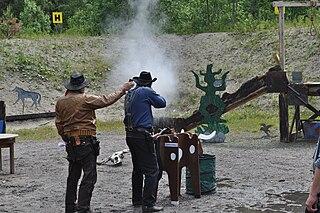
Cowboy action shooting is a competitive shooting sport that originated in Southern California in the early 1980s, at the Coto de Caza Shooting Range in Orange County, California. Cowboy action shooting is now practiced in many places with several sanctioning organizations including the Single Action Shooting Society (SASS), Western Action Shootists Association (WASA), and National Congress of Old West Shooters (NCOWS), Single Action Shooting Australia (SASA), Western 3-Gun as well as others in the U.S. and other countries.

On June 13, 2015, 35-years-old James Lance Boulware shot at the Dallas Police Department from an armored van with what appeared to be a semi-automatic rifle. The shooting occurred at the department's headquarters in the Cedars neighborhood of Dallas, Texas. He then led the police in a chase to nearby Hutchins, where he remained in the van in a standoff with police. The standoff ended when a police sniper fired a round from a .50-caliber rifle, disabling the engine block, as well as additional rounds into the vehicle to kill the driver. After sending in robots to confirm the shooting and attempt to make entry into the vehicle, water charges were used to breach the windshield. Police then verified that the suspect was the only person in the vehicle and that he was dead. Police also found four bags outside of the police headquarters containing pipe bombs.
Lauretha A. Vaird was a Philadelphia Police Department officer who was shot dead by the rapper Christopher Roney aka "Cool C" during a botched armed bank robbery in January 1996. Roney attempted to rob the bank with another rapper, Warren McGlone aka "Steady B", and another man, Mark Canty. During the robbery, Vaird was mortally wounded by a gunshot wound in the abdomen and died soon after. Vaird was Philadelphia's first female police officer to be shot and killed in the line of duty.
Joseph "Joe Joe" Rideau and Christopher "Chris" Rideau, were well known criminals from New Orleans, Louisiana. Authorities said the brothers terrorized the streets of New Orleans and built a reputation as brazen gangsters. For years the duo were implicated in a host of crimes, but they were rarely convicted because of reluctant witnesses and missing evidence that doomed cases. In 2001 the brothers crime sprees would come to an end after a violent stand off in which the elder brother Joseph was killed. The wild incident made national headlines in the media. Christopher was sentenced to 10 years in prison for his role in the incident and was released from prison in 2010 with time off for good behavior. In 2011, he was viciously gunned down in New Orleans.
References
- 1 2 "Archived copy" (PDF). Archived from the original (PDF) on 2015-09-12. Retrieved 2014-11-25.
{{cite web}}: CS1 maint: archived copy as title (link) - ↑ CNN.com - 'Blanket commutation' empties Illinois death row - Jan. 13, 2003